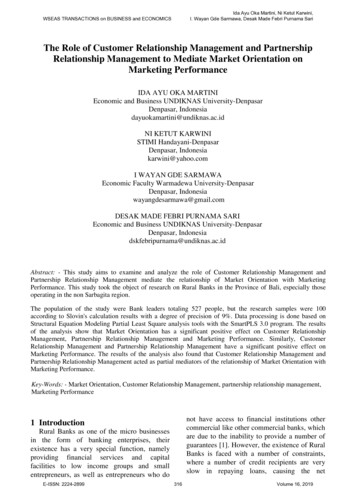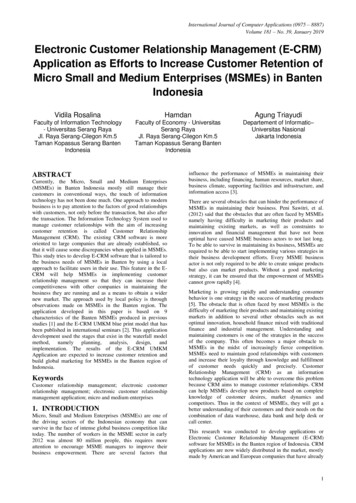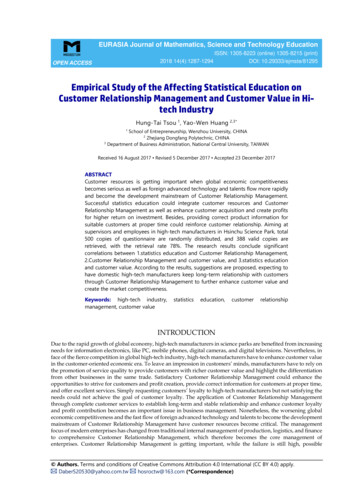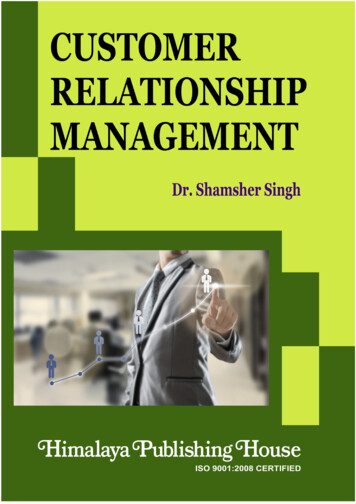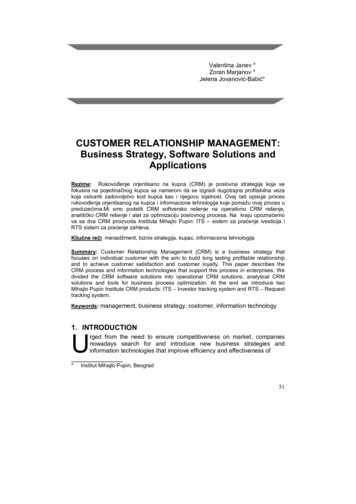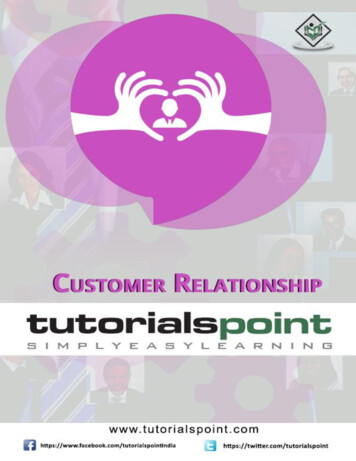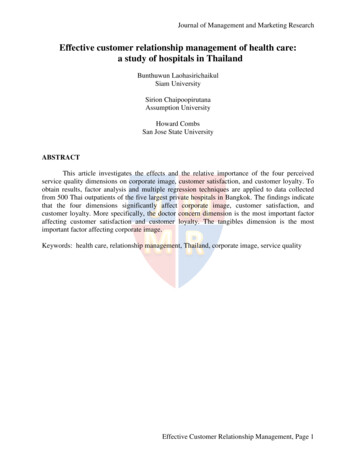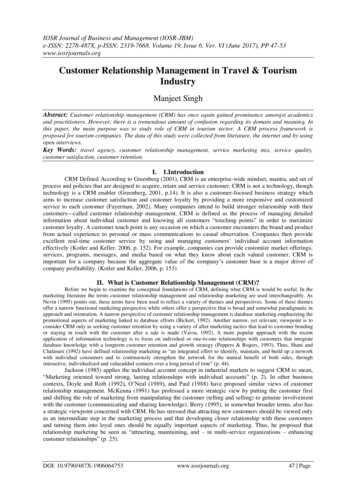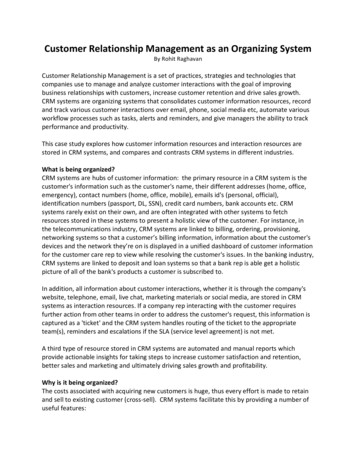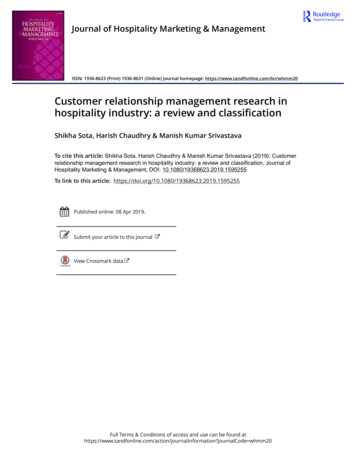
Transcription
Journal of Hospitality Marketing & ManagementISSN: 1936-8623 (Print) 1936-8631 (Online) Journal homepage: https://www.tandfonline.com/loi/whmm20Customer relationship management research inhospitality industry: a review and classificationShikha Sota, Harish Chaudhry & Manish Kumar SrivastavaTo cite this article: Shikha Sota, Harish Chaudhry & Manish Kumar Srivastava (2019): Customerrelationship management research in hospitality industry: a review and classification, Journal ofHospitality Marketing & Management, DOI: 10.1080/19368623.2019.1595255To link to this article: shed online: 08 Apr 2019.Submit your article to this journalView Crossmark dataFull Terms & Conditions of access and use can be found ation?journalCode whmm20
JOURNAL OF HOSPITALITY MARKETING & 95255Customer relationship management research in hospitalityindustry: a review and classificationShikha Sota, Harish Chaudhry and Manish Kumar SrivastavaDepartment of Management Studies, Indian Institute of Technology Delhi, New Delhi, IndiaABSTRACTThis study reviews research articles published in the area of CustomerRelationship Management (CRM) in the hospitality industry. The aim ofthis article is to systematically review the entire hospitality CRM literature to identify topical themes and trends. For this systematic literaturereview, four databases, namely, Elsevier, Emerald Insight, Sage, andTaylor and Francis were chosen to identify the research work publishedin the said arena. A total of 136 articles with 9900 citations in 46journals were chosen from the four databases as they contained therelevant articles. These research papers were reviewed and classifiedbased on their year of publication, journal of publication, databases,topics and key themes that emerged over the years. The gaps andtrends were also identified to suggest further scope of research.KEYWORDSCustomer relationshipmanagement; relationshipmarketing; customer;hospitality; literature review;systematic �.IntroductionThe global hospitality industry is on the upward trajectory, with numbers of consumersincreasing every year. The flourishing travel and tourism industry is one of the reasons forgrowth in the hospitality sector. The hospitality industry which is a customer-centricindustry relies heavily on customers’ information and therefore Customer RelationshipManagement (CRM) is implemented worldwide in this sector (Sigala, 2005). A researchwas carried out by Yoo, Lee, and Bai (2011) on significant trends in the hospitalityindustry, which states that CRM is one of the most popular research topics for hospitalityindustry academicians. The research and consultancy organization Gartner (2018) statesthat 39.5 billion US dollars were spent on CRM software in the year 2017 and the marketwill grow at 16%. CRM has also been cited among the top five significant technologies inthe world (Luftman et al., 2012). The competition in the hospitality sector is rising andCONTACT Shikha Sotashikhasota@gmail.comDepartment of Management Studies, Indian Institute ofTechnology Delhi, New Delhi, 110016 IndiaColor versions of one or more of the figures in the article can be found online at www.tandfonline.com/whmm. 2019 Taylor & Francis Group, LLC
2S. SOTA ET AL.therefore there is a lot of pressure to retain and augment the customer base. Customers’expectations are on the rise and are setting a new benchmark in the industry (Hussain,Rahman, & Hassan, 2012a).Given the importance of CRM in the hospitality industry, the purpose of this paperis to synthesize the CRM research in the hospitality industry. The idea is to understandhow CRM has evolved over the years in the hospitality industry and to discuss the gapsthat need to be researched and explored further. First, our analysis offers a classificationof research articles on the basis of year, journal, and database. The analysis has beendone for all studies published on hospitality CRM from 1988 to 2018 in four leadingdatabases. Second, the entire literature has been divided into three time periods tounderstand the trends that emerged over the years in CRM hospitality research. Themajor areas of research under these time periods are discussed. Third, the majorthemes that emerged over the years are discussed. It is followed by a brief explanationof some of the significant works done under each theme. The major themes that arediscussed have been adapted from the previous studies to maintain consistency anda few new ones have been added to make the analysis exhaustive and to offer moreclarity. Finally, the last section has a description of the key research findings followedby a discussion on the unexplored areas of CRM in hospitality and provides questionsfor further research. A thematic bibliographic classification of articles is also presentedin the last section of this paper. Although, there have been some recent CRM inhospitality literature review publications by Rahimi, Köseoglu, Ersoy, and Okumus(2017) and Law, Fong, Chan, and Fong (2018), but this paper acts as an extension tothose previous studies as it covers aspects which have not been studied in earlierstudies. The review by Rahimi et al. (2017) covers this subject from papers publishedin fourteen leading journals whereas this study covers papers published in four majordatabases in forty-six journals. The review paper by Law et al. (2018) analyzed 111papers and thematically analyzed the paper, along with pitfalls in the CRM research,whereas this study not only analyzed papers thematically but it covers classification onthe basis of year, databases along with bibliographic classification. Also, the additionalpapers published in the last one year have also been included in this study. Therefore,this study supplements the previous review studies (Law et al., 2018; Maggon &Chaudhry, 2015; Rahimi et al., 2017) done on CRM in the hospitality industry. Inour aim of understanding the current knowledge on hospitality CRM, we have synthesized and analyzed the existing literature from different perspectives by providingvarious classifications. Therefore, this paper is relevant for researchers, faculty, andpractitioners of CRM especially in the hospitality industry as it is integrating the CRMstudies in hospitality as well as pointing out the direction of future studies.Literature reviewThe term relationship marketing was first deployed by Berry (1983), which was based on theidea of retention and long-term relationship with customers. Loyalty programs have beenconsidered as one of the most used approaches to maintain a long-term relationship withcustomers and to entice them for repeat purchases. The loyalty programs were first introducedby American Airlines in 1981 (Xiong, King, & Hu, 2014) for CRM. Hospitality industry also
JOURNAL OF HOSPITALITY MARKETING & MANAGEMENT3followed suit and it is also one of the industries which heavily deploys CRM programs tomaintain relationships with customers (Berman, 2006; Xiong et al., 2014; Yoo et al., 2011).Some of the notable and most cited works in the area of CRM have been done by Buttle(1999, 2001, 2004, 2009)); Chen and Popovich (2003); Grönroos (1997); Payne and Frow(2005, 2006)); Frow and Payne (2009); Reinartz, Krafft, and Hoyer (2004); Verhoef (2003);and Winer (2001). Relationship marketing was suggested as the new paradigm byGrönroos (1997), and argued that 4Ps have dominated the marketing thought for a verylong time. Buttle (1999) also furthered the idea and reasoned that marketers need to shifttheir focus from the conventional transaction-based approach to relationship-drivenapproach. Thereafter, the concept of customer portfolio analysis was pioneered byButtle (2001), who stated that not all customers have equal value for the company; instead,an organization must focus on strategically significant customers. Payne and Frow (2005)argued that CRM is usually viewed as a tactical technology solution and not seen asa customer-centric strategy. Therefore, they suggested that CRM must be seen froma strategic vision which aims at understanding the nature of customer value.The literature on CRM is immense and various researchers have attempted to aggregateand review CRM literature in general (Das, 2009; Ngai, 2005) and a few have synthesizedCRM literature in the hospitality industry (Law et al., 2018; Maggon & Chaudhry, 2015;Rahimi et al., 2017) as well. Law et al. (2018) analyzed CRM literature in hospitality andclassified the articles into five heads; namely, organizational support, CRM planning andimplementation process, customer perspectives and characteristics, technology and tools,and outcome and impact. Another review has been done by Rahimi et al. (2017), whereinthe CRM literature was classified on the basis of industry and components of CRM, whichare people, process, and technology. Maggon and Chaudhry (2015) attempted to reviewthe research articles from the year 2001 to 2003 on hospitality and tourism with all focuson Relationship Marketing (RM) and CRM. Their study did thematic classification from19 journals of 78 research papers. The major shifts that had happened in the area of RMand CRM along with techniques applied in the respective articles were covered.Not just CRM in hospitality sector exclusively, but a few researchers have compiled andanalyzed the CRM literature in the general. Ngai (2005) has done an extensive literaturereview of CRM for twenty years from the year 1999 to 2002. All the papers were classifiedinto five categories, which are general, marketing, sales, service and support, and IT andIS. Another extensive literature review on CRM has been done by Das (2009), whereinarticles on Relationship Marketing (RM) from 1994–2006 has been reviewed. His studyclassified the articles into three time periods to understand how RM research has progressed over the years. Sota, Chaudhry, Chamaria, and Chauhan (2018) reviewed the CRMliterature published in top ten marketing journals from 2007 to 2016 and classified theliterature on the basis of journals, database, year, methods used and key topics covered.The contemporary literature on CRM is more focused on advanced technologies, use ofsocial media (Chan, Fong, Law, & Fong, 2018; Guha, Harrigan, & Soutar, 2018; Kantorová& Bachmann, 2018; Sigala, 2018), and big data & analytics (Anshari, Almunawar, Lim, &Al-Mudimigh, 2018; Talón-Ballestero, González-Serrano, Soguero-Ruiz, Muñoz-Romero,& Rojo-Álvarez, 2018; Zerbino, Aloini, Dulmin, & Mininno, 2018). The use of socialmedia platforms by customers and organizations to communicate and maintain relationships is researched extensively as social media is surpassing the traditional methods ofcommunication. At the same, a huge amount of data is being captured by organizations in
4S. SOTA ET AL.this digital era, which in turn is bringing big data analytics into CRM systems. The latestresearch in big data is expected to allow more interactivity with customers along withpersonalization and customization (Anshari et al., 2018). Technology has always been animportant CRM tool and continues to be the one with the extensive use of Internet AccessDevices (IAD), Personal Digital Assistant (PDA), and social media platforms (Gan, Sim,Tan, & Tna, 2007). Dewnarain, Ramkissoon, and Mavondo (2018) proposed a conceptualframework of social CRM, which stated that the integration of social media with CRMdimensions act as enablers of customer engagement. Even though the current focus ofCRM is on new technologies, some of the latest studies reiterate that learning orientationand knowledge management along with an appropriate customer strategy remain the keyto effective CRM (Rahimi, 2017a).Research methodologyTo understand the progression in a particular field and write review papers, researchersundertake various methods like systematic literature review, meta-analysis or narratives. Allthe methods are unique and are employed keeping in mind the end objective. A systematicliterature review can synthesize and categorize the data into various heads, like patterns,disciplines, methods used and many more (Pickering & Byrne, 2014). These reviews are,therefore, comprehensive, structured, and systematic. Categorization is one of the importantsteps towards synthesis and analysis of data as it helps in integration and looking at a broaderpicture (Runyan & Droge, 2008). This research attempts to integrate the research work donein the hospitality sector in terms of CRM and classify papers into various heads.The systematic review of literature involves various steps; defining topic, formulatingresearch topics, identifying databases and keywords, article search and selection, and classification and analysis (Pickering & Byrne, 2014; Prayag & Ozanne, 2018). The similar stepshave been followed in the current study as well (Figure 1). For this study, as specified, focuseson CRM articles published in the hospitality industry are considered. Four databases wereidentified namely Emerald Insight, Elsevier, Sage, and Taylor and Francis for this study. Thesedatabases are chosen as they are known to contain the articles related to a wide arena ofmanagement. From these databases, the articles and research papers published in the hospitality sector worldwide were chosen with a special focus on CRM. The keywords used were“Customer Relationship Management in the Hospitality industry” and, “CRM in hospitality”.These particular keywords are used as the objective of the paper is to synthesize and analyzethe CRM literature particularly in the hospitality industry and therefore these keywords veryaptly suffice the requirement. Also, the previous studies done with similar objectives used thesame keywords (Law et al., 2018). Once the keywords generated the articles, all the titles weremanually read one by one; the ones which very specifically talk about CRM in hotels werechosen. The idea is to understand the CRM research in hospitality and therefore any articlethat contained any research about CRM only in hospitality was chosen. In case of confusion,the abstracts were read to make a decision. In case, any article was pertaining to CRM ingeneral and not specifically to hotels, it was not chosen for the study. The manual filtering wascarried out as there were some articles that seemed relevant at the outset, but they were notrelated to the study. Apart from these four databases, a search was done from Scopus to findmore relevant articles, using the same keywords. Most of the articles found were redundant,but eleven articles were found which were relevant to the research topic. Out of these eleven,
JOURNAL OF HOSPITALITY MARKETING & MANAGEMENT5Preliminary search- Four data bases- Elsevier, Emerald Insight, Sage and Taylor andFrancisAdvanced Search- Descriptor: CRM in hospitality as keyword, title orabstractManual screening-Relevant area, discipline-Explicitly or implicitly belonging to topic of studySearch for Scopus indexed articles to find more relevantarticles.Redundant articles were discarded and eleven relevantarticles were foundFinal set of articles- 136 articles with 9900 citations-Published in 46 journalsFigure 1. Systematic literature review flowchart.four conferences paper were also found relevant to this study. They have been chosen to bea part of this systematic review to make this study as exhaustive as possible. A total number of136 articles emerged out which seemed relevant for the study. No time frame was mentionedduring the search to extract all possible papers on CRM in hospitality. After all the articleswere gathered, the time period of these published papers came out to be from 1988 to 2018.Classification and analysisThe systematic review of the literature has been carried out by classification of variouskinds. Firstly, the entire classification is done on the basis of year of publication, journal ofpublication and database of publication. This is done to understand the spread of researcharticles across years and journals. Secondly, the entire literature is divided into three timeperiods to understand hospitality CRM growth and trends. The major developments inthese time periods are discussed to understand the CRM trajectory over the years. Thirdly,the classification has been done on the basis of key topics that emerged from thehospitality CRM literature. The key topics were decided looking at the previous similarand recent studies (Rahimi et al., 2017; Law et al., 2018). Rahimi et al. (2017) classifiedpapers into three themes namely, technology, customer satisfaction & loyalty, and firm’sperformance. Law et al. (2018) classified papers into five themes, which are CRM planning& implementation, organizational support, technology & tools, customer perspectives, andoutcomes & impact. We chose the same themes and added a few more making it a total ofeight themes. This has been done to be specific and to offer more clarity. For example,loyalty has been taken as a separate theme in our study unlike the previous studies asa major chunk of hospitality CRM literature is dedicated to it. We have also addedgeneral/overview theme as there were papers which covered CRM concepts, frameworks
6S. SOTA ET AL.and literature review. Therefore, in our attempt to be exhaustive and provide more clarity,we adapted the existing themes from literature and added a few more. The trends andchanges that emerged in the literature published on CRM in the hospitality industry areobserved and are mentioned in the results. The bibliography of reviewed literature issummarized in Table 2.Distribution of articles by year of 201620172018No. of papersThe number of articles that have been published over the years is depicted in Figure 2. Forunderstanding the trends and changes that occurred in hospitality CRM publication, the entireCRM hospitality research has also been divided into three time periods. The papers have beenclassified as published between 1988–2000, 2001–2010, and 2011–2018 (Figure 3). Out of thetotal 136 papers, 8.08 percent were published during the first time period, 30.88 percent werepublished during the second time period and 61.02 percen twere published during the third timeperiod.There has been a tremendous increase in the number of papers published after 2010;in-fact the total numbers of papers published in the third period are more than thecombined paper published in the first two phases.YearNo.of papersFigure 2. Distribution of articles by year of ime period (year)Figure 3. Classification of articles by time period.2011-2018
JOURNAL OF HOSPITALITY MARKETING & MANAGEMENT7It can be seen that there has been a significant increase in the interest in the area by theupward trend in the number of articles. It signifies that the hospitality industry has beenusing CRM as a strategy to engage and build relationships with customers. Even though theconcept of CRM emerged around four decades back, it continues to be very popular andprevalent in the hospitality industry to date. A dip can be seen in CRM hospitality paperpublishing after 2016 as 9 papers were published in 2017 and 10 were published in 2018.This dip perhaps can be explained by the latest concept of Customer Experience (CX), whichis considered to be the successor of CRM (Palmer, 2010; Schmitt, 2010). Palmer (2010)argues that CRM has not created the expected level of value for customers and results fororganizations. He further argues that ‘Customer Experience Management (CXM)’ can be anintegrating framework that can overcome the limitations of CRM. Therefore, the dip in thenumber of papers in the last two years could be due to a shift in attention to CXM.1988-2000 time periodThe oldest article which was found relevant for this systematic literature review was publishedin the year 1988. After the first article that was found relevant for this study, the next articlepublished specifically about CRM in the hospitality industry was after ten years of the firstpublication, i.e. in the year 1998. Haywood (1988) researched about cultivating alliances withcustomers for repeat purchases in the hospitality industry. After 1998, there has beena continuity in published research about CRM in the hospitality industry.Not many papers on CRM in hospitality were published during this period; just 11papers out of the total count of 132. Maximum papers were published in the area ofloyalty and then in technology. There were no papers on strategy, outcomes or organizational structure and culture during this phase. The two most cited papers were publishedduring this time period and both the papers (Bowen & Shoemaker, 1998; Kandampully &Suhartanto, 2000) were pertaining to customer loyalty.2001-2010 time periodDuring this phase, the use of technology in CRM was the highlight. Many researchersstudied the use of technology to collect, store, analyze and use customer data for marketing and maintaining long-term relationships with customers. Another focus area forresearchers during this period was the outcomes of CRM. The outcomes were discussedin various forms like customer retention, customer loyalty, word-of-mouth, repeat purchase, customer satisfaction, and financial performance. Another major shift during thisperiod was the emergence of articles related to organization structure and culture. In fact,12 percent of the total articles during this time period were pertaining to this theme. Therewere no articles in the previous time period that discussed the role of organizationalstructures or culture on CRM.2011-2018 time periodThis time period saw the maximum publications; 61 percent of the total articles on CRMin hospitality industry belonged to this time period. This clearly depicts that even this areais getting a lot of traction from academicians, even during recent times. Keeping in syncwith the trends of the previous years, technology, loyalty, and outcomes remained thefocus of this phase also. Majority of the articles that were published focused on theoutcome and benefits of CRM followed by technology and loyalty. The theme that
8S. SOTA ET AL.emerged in this period and was not seen in the previous phase was strategy and also, therehas been a substantial increase in the articles pertaining to loyalty. Customer loyaltycontinued to be one of the major themes during this time period also.Distribution of articles by databaseThe distribution of research papers by the database is shown in the following Figure 4.Emerald insight contained 29.6 percent of the total published articles, whereas Taylor andFrancis, Elsevier, and Sage contained 23.7 percent, 20.7 percent, and 18.5 percent respectively. The rest 8.1 percent of articles were found via Scopus, published in differentjournals, out of which four were conference proceedings.Distribution of articles by journalsA total number of 46journals were identified through the chosen set of databases for thisstudy. Out of the total 136 articles identified for this study, the maximum numbers of articlesare published in International Journal of Contemporary Hospitality Management.Approximately 21% of the articles are published in this journal. Another journal whichcontained many articles is International Journal of Hospitality Management, which has 14%of the total research papers published. Journal of Hospitality and Tourism Managementcontains 6% of the total articles published. Journal of Hospitality Marketing & Management(previously known as Journal of Hospitality & Leisure Marketing) has 5% of the total articlespublished. The tabular depiction of journal wise classification of articles is shown in Table 1.CRM in hospitality and related themesNo. of articlesThe key areas wise classification of the reviewed articles is depicted in Figure 5. The CRM inhospitality articles were classified on the basis of key topics that they covered. Apart from thegeneral articles which explain about CRM, its definitions, and give an overview of CRM,authors have identified seven themes that emerged out of these studies. The classification ofarticles by key topics published during three different time periods is depicted in Figure 7.454035302520151050EmeraldInsightTaylor &FrancisSageDatabaseFigure 4. Database wise classification.ElsevierOthers
JOURNAL OF HOSPITALITY MARKETING & MANAGEMENT9Table 1. Journal wise classification of CRM in hospitality rnal NameInternational Journal of Contemporary Hospitality ManagementInternational Journal of Hospitality ManagementJournal of Hospitality and Tourism ResearchJournal of Hospitality Marketing and ManagementJournal of Travel and Tourism MarketingJournal of Vacation MarketingTourism and Hospitality ResearchAsia Pacific Journal of Tourism ResearchJournal of Hospitality and Tourism TechnologyTourism and Hospitality ResearchTourism ManagementCornell Hotel and Restaurant Administration QuarterlyTourism EconomicsInternational Journal of Hospitality and Tourism AdministrationCornell Hospitality QuarterlyTotal Quality Management and Business ExcellenceJournal of Travel ResearchWorldwide Hospitality and Tourism ThemesJournal of Marketing Practice: Applied Marketing ScienceManaging Service Quality: An International JournalJournal of Hospitality and Marketing ResearchJournal of Consumer MarketingTourismJournal of Marketing CommunicationsJournal of Quality Assurance in Hospitality and TourismJournal of Teaching in Travel and TourismAnatoliaTourismosQuality-Access to SuccessJournal of Services MarketingThe Service Industries JournalInternational Journal of Revenue managementInternational Journal of Business and Management ScienceInternational Journal of Electronic Customer Relationship ManagementInternational Journal of Culture, Tourism and Hospitality ResearchCurrent Issues in TourismJournal of Relationship MarketingJournal of Modelling in ManagementCorporate Reputation ReviewVINE Journal of Information and Knowledge Management SystemsTourism ReviewFIIB Business ReviewJournal of Travel and Tourism MarketingJournal of Foodservice Business ResearchElectronic Commerce Research and ApplicationsTourism Management 111111111111111Nearly eight percent of the total articles focus on the general overview of CRM in thehospitality industry. The number of such articles has increased over the period of time andthe authors have attempted to explain the concept of CRM (Haywood, 1988), compared itwith another similar phenomenon (Geddie, DeFranco, & Geddie, 2002, 2005) identifiedthe challenges faced by CRM (Jauhari, 2012), and some have studied the latest trends andfuture directions (Line & Runyan, 2012).Figure 6 depicts the word cloud of titles of all the selected articles of hospitality CRM.Word clouds are a visualization method for text to give an overview by extracting thewords that appear with the highest frequency (Heimerl, Lohmann, Lange, & Ertl, 2014).
S. SOTA ET AL.No. of articles104035302520151050Key subjectsFigure 5. Subject wise classification.Figure 6. Word cloud of titles of selected articles.The picture very clearly illustrates that the dominant words used in the titles of theselected studies are loyalty, hospitality, relationships, marketing, and technology. Thisword cloud is evidence that CRM studies are hugely focusing on themes like loyalty,relationships, and technology.
No. of papersJOURNAL OF HOSPITALITY MARKETING & MANAGEMENT1120181614121086420Key topics1988-20002001-20102011-2018Figure 7. Classification of articles by key topics published during different time periods.TechnologyTechnology has emerged out to be the most significant aspect of CRM in the studies donein the past. Hospitality organizations have been using technology extensively to maintaina long-term relationship with their guests. The technology employed is in various formsand platforms like the website, database marketing, social media page and many more.Gilbert, Powell-Perry, and Widijoso (1999) published one of the very first papers on theuse of the internet as a CRM strategy, specifically pertaining to the hospitality sector. Theirpaper, using a qualitative study, concluded that the World Wide Web could be thesolution to the challenges that hospitality industry was facing and it could also be usedas a sophisticated RM tool. Diffley, McCole, and Carvajal-Trujillo (2018) examined the useof social CRM, which is the use of social media platforms for maintaining relationshipswith customers and found out that it enhances a firm innovativeness and also leads toincreased financial performance. Talón-Ballestero et al. (2018) researched how using bigdata from CRM information systems helps in profiling clients. Their study aided inidentifying the profiles of first-timers and repeat guests for hotels. There have been variousother technology related studies like pertaining to data mining (Dursun & Caber, 2016),usage of Facebook (Su, Mariadoss, & Reynolds, 2015a), usage of website features (Bilgihan& Bujisic, 2015); mobile technology (Anne Coussement & Teague, 2013), and informationsystems (Ku, 2010).OutcomesA significant amount of CRM research has been devoted to understanding the performance and outcome of CRM programs. Rahimi and Kozak (2017) studied the impact ofCRM on customer satisfaction of budget hotels of the United Kingdom. Their studyconcluded that CRM systems lead to efficient reservations process and check-in systemsand, customization, but at the same time, efficient systems alone do not lead to the success
12S. SOTA ET AL.T
The literature on CRM is immense and various researchers have attempted to aggregate and review CRM literature in general (Das, 2009; Ngai, 2005) and a few have synthesized CRM literature in the hospitality industry (Law et al., 2018; Maggon & Chaudhry, 2015; Rahimi et al., 2017) as well. Law et al. (2018) analyzed CRM literature in hospitality and
